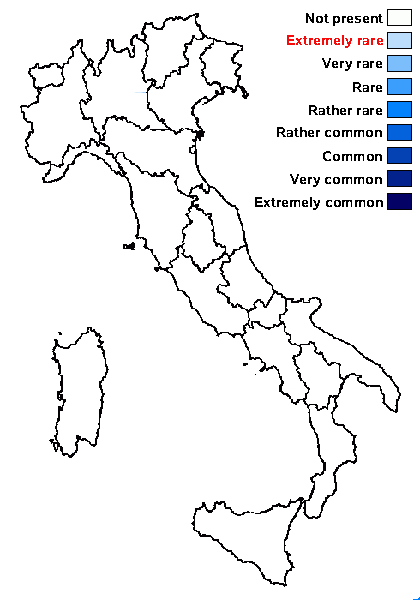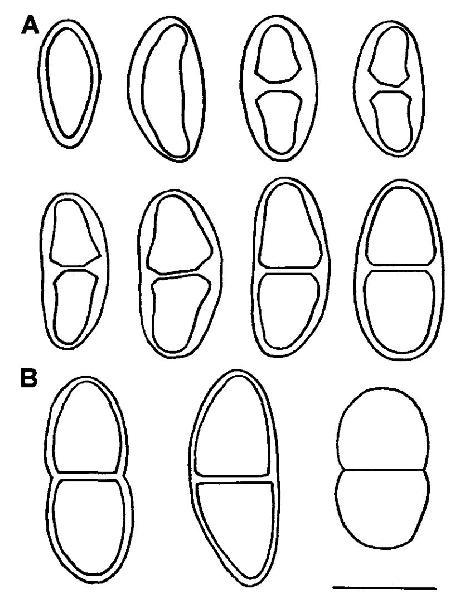Buellia dives Th. Fr.
Öfvers. K. Svensk. Vetensk.-Akad. Förhandl., 21: 272, 1865.
Synonyms:
Distribution:
Description: Thallus crustose, episubstratic, whitish to pale grey, thin and smooth or rimose to thicker and areolate, often delimited by a black prothallus. Apothecia lecideine, black, at first immersed, later becoming adnate, up to 0.65 mm across, with a flat to slightly convex, epruinose disc and a persistent, smooth proper margin which is usually surrounded by a thalline rim in young apothecia. Proper exciple 40-80 µm wide, the outer rim dark brown, composed of up to 7 µm wide cells with apical brown caps, paler within; epithecium dark brown, with or without an epipsamma of K+ red crystals (norstictic acid); hymenium colourless, 90-110 µm high, without oil droplets; paraphyses simple or branched in upper part, c. 2 µm thick at mid-level, the apical cells (2-)2.5-3.5(-4) µm wide, with a dark cap; hypothecium dark brown, with oil droplets. Asci (12-)16-spored, clavate, Bacidia-type. Ascospores 1-septate (rarely a few becoming 3-septate), brown, straight or slightly curved, 14-)15.5-18(-21) x (6-)7-8(-9) µm, the walls without thickenings at maturity, but with weak subapical thickenings when young, Callispora, with a microrugulate ornamentation. Photobiont chlorococcoid. Spot tests: K+ yellow to orange (rarely red), C-, KC-, P+ faintly yellow to yellow-orange. Chemistry: atranorin, plus sometimes variable amounts of norstictic and connorstictic acids.Note: a rare epiphytic species growing in old, humid montane forests, known from Atlantic Europe (Spain and Norway, see Giralt & al. 2002), but recently also found in the Carpathians and in the Pacific part of North America (Khodosovtsev & al. 2024). To be looked for in Italy.
Growth form: Crustose
Substrata: bark
Photobiont: green algae other than Trentepohlia
Reproductive strategy: mainly sexual
Most common in areas with a humid-warm climate (e.g. most of Tyrrenian Italy)

Predictive model

sOURCE: Giralt M., Tønsberg T. & Holien H. (2002) Lichenologist 34(1): 1-5 Notes on the misunderstood Buellia dives (Th. Fr.)Th. Fr.
Ascospore-ontogeny and ascospore variability of Buellia dives {Tonsberg 6160b). A, young ascospores
with slight subapical thickenings and hence of the Callispora-type; B, mature ascospores. Scale=10 (i
Growth form: Crustose
Substrata: bark
Photobiont: green algae other than Trentepohlia
Reproductive strategy: mainly sexual
Most common in areas with a humid-warm climate (e.g. most of Tyrrenian Italy)

Predictive model


